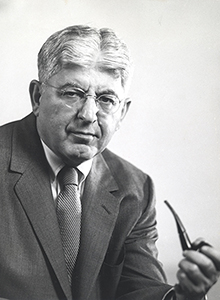Federal Reserve Reform Act of 1977
November 16, 1977

The Federal Reserve Reform Act of 1977 was instrumental in shaping the current Federal Reserve System. The Reform Act made explicit the Federal Reserve’s objectives, increased its transparency and accountability to Congress, and changed the selection criteria for Federal Reserve Bank directors. Congress was motivated to increase the role and accountability of the Federal Reserve during the 1970s because of the adverse macroeconomic conditions of the time. The 1970s was a time of high inflation and unemployment, collectively referred to as “stagflation,” which led to the enactment of the Reform Act in November 1977.
When the Federal Reserve was first established in 1913, Congress directed it only to “furnish an elastic currency, to afford means of rediscounting commercial paper” and “to establish a more effective supervision of banking in the United States.” In effect, the Federal Reserve’s central founding purpose was to provide a more flexible supply of currency and bank reserves in order to stem banking panics. The original act assumed continued adherence to the gold standard regime, which tended to keep inflation under control automatically over the long run. In the 1940s, with the Great Depression of the previous decade in mind, Congress passed the Employment Act of 1946, which declared that federal government policy was “to promote maximum employment, production, and purchasing power.”
By the 1970s, the gold standard had been abandoned and the worsening inflation and unemployment experience called into question the conduct of monetary policy. The 1977 Reform Act amended the original act by explicitly directing the Federal Reserve to ”maintain long run growth of the monetary and credit aggregates commensurate with the economy’s long run potential to increase production, so as to promote the goals of maximum employment, stable prices, and moderate long-term interest rates.”
Although the Reform Act directs the Federal Reserve to pursue three policy goals, the Federal Reserve focuses on employment and prices.1 The third goal—“moderate long-term interest rates”—is often not explicitly discussed. Former Federal Reserve Governor Frederic Mishkin explains that this is because “long-term interest rates can remain low only in a stable macroeconomic environment, these goals are often referred to as the dual mandate; that is, the Federal Reserve seeks to promote the coequal objectives of maximum employment and price stability.”
Increased Oversight
In addition to expanding monetary policy objectives, the Reform Act also increased congressional oversight of the Federal Reserve by establishing a monetary policy reporting system. The Reform Act required the Board of Governors to report at semiannual hearings before both the House and the Senate about the Federal Reserve’s and Federal Open Market Committee’s objectives, performance, and plans in regards to the “growth or diminution of monetary and credit aggregates for the upcoming twelve months.” 2
The Reform Act further increased congressional oversight by requiring Senate confirmation of the Board of Governors’ chairman and vice chairman and by limiting their positions to four-year renewable terms. The goal of these reforms was to increase communication between Congress and the Federal Reserve about the nation’s monetary policy.
In addition, the Reform Act changed the selection criteria of Federal Reserve Bank directors by prohibiting discrimination on the basis of race, creed, color, sex, or national origin and increasing the diversity of represented economic interests. The Reform Act required Reserve Bank directors to represent the interests of “agriculture, commerce, industry, services, labor, and consumers.” This expanded on the original Federal Reserve Act of 1913, which had only mentioned representation of agricultural, commercial, and industrial interests.
Lastly, the Reform Act aimed to decrease potential conflicts of interest by prohibiting Federal Reserve directors, officers, and employees from participating in any matters that affect their own financial interests. For example, a conflict of interest may arise if a Federal Reserve employee owns stock in a member bank that she supervises. In order to avoid this conflict, the Reform Act prohibits Federal Reserve employees from holding stocks or debt securities of any bank and their affiliates.
Endnotes
- 1 For more information on the dual mandate see http://www.chicagofed.org/webpages/publications/speeches/our_dual_mandate_background.cfm" and http://www.richmondfed.org/publications/research/economic_brief/2011/pdf/eb_11-12.pdf.
- 2 Currently, the Federal Reserve publishes data on two different types of monetary aggregates, M1 and M2. M1 measures the amount of circulating currency, and checking and demand deposits. M2 includes M1 plus savings, and money market accounts and additional funds. For more information on monetary aggregates, see the Federal Reserve’s weekly H.6 report at http://www.federalreserve.gov/releases/h6/. Credit aggregates include credit extended to the federal, state and local governments, households, and nonfinancial businesses.
Bibliography
Federal Reserve Act, 1913. Pub. L. 63-43, ch. 6, 38 Stat. 251 (1913).
Federal Reserve Reform Act of 1977. Pub. L. 95-188, 91 Stat. 1387 (1977).
Federal Reserve Bank of Chicago. “The Federal Reserve’s Dual Mandate.” Accessed November 15, 2013, http://www.chicagofed.org/webpages/publications/speeches/our_dual_mandate_background.cfm.
Mishkin, Frederic S., “Monetary Policy and the Dual Mandate,” Speech given at Bridgewater College, Bridgewater, VA, April 10, 2007.
Steelman, Aaron. “The Federal Reserve’s ‘Dual Mandate’: The Evolution of an Idea.” Federal Reserve Bank Richmond Economic Brief no. 11-12 (November 2012).
Written as of November 22, 2013. See disclaimer.



